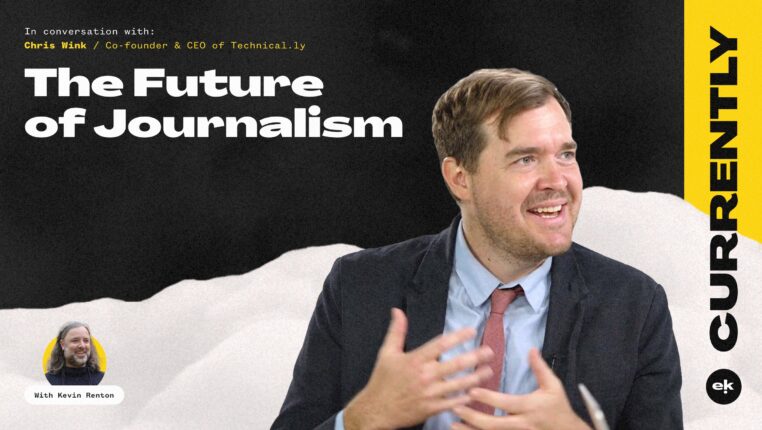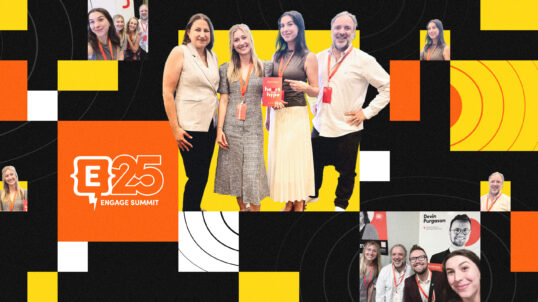Volt is growing up.
It’s been nearly six years since we flipped on the lights at our digital magazine for higher ed marketers. We don’t need to tell you that a lot has changed since 2019 or that it’s never been more difficult to succeed as a publisher. And yet, while that’s true, Volt has a larger reach by all measurements than it ever has, and it continues to grow.
We’ve learned a lot these last few years about building a successful B2B publication in this decidedly fragmented, challenging media landscape — lessons that any content publisher can and should take to heart.
Key Metrics | Platform Growth | SEO Lives | Audience Surprises
Follow the Data | First Impressions | Tech Stack
Volt + EK | Editorial Independence | B2B = Community
10. Digital performance is much more than web traffic.
This is fast becoming a truism for digital media and content marketing, alike, and publishing Volt put us in position to realize this early on specifically for B2B publishing. Social media platforms reward on-platform engagement and SEO is declining (more on that in a second), meaning you have to reach your audience where they are — without expecting to pull them back to your website. Yes, your web traffic is still hugely important, but the amount and quality of off-platform engagement that a publisher gets on social media, through their newsletters, on their YouTube channel, on their podcast platforms, etc., is increasingly valuable and creates the composite of total audience engagement that is the true, total currency of successful digital publishing right now.
9. Platform growth takes time and patience.
Off-platform channel growth may be the key to growing a valuable audience, but it’s no easy feat. The magic trick that people don’t see when you talk about publishing a magazine is building the follower counts on channels that allow your content to be read or heard or seen and that give your content the platform it deserves. When it comes to newsletters, arguably the best place to directly reach and engage your audience that’s not your website, you have to find a balance between building a list and having an engaged list. We’ve been lucky that we’ve been able to organically build Volt’s list of newsletter subscribers, but to accelerate it is what’s so hard from the publisher’s point of view. Building your followings on other content channels like Spotify and YouTube is also an exercise in trial-and-error as well as patience, and that’s before you get to the icing on the cake: cross-pollinating your channels with your audience. If they get your newsletter, do they follow your podcasts on Spotify? If they like your content on LinkedIn, have they found you on YouTube? And so on and so on. It’s not easy, it takes time, but if you’re consistent in publishing and you test and learn, the followers slowly build, until one day they start to join in droves — fingers crossed.
8. SEO isn’t dead.
The decline of SEO — driven first by the rise of zero-click search, now by the rise of AI search tools — is part of why it’s so important to reach your audience away from your website. But what we have seen through Volt is that SEO is not, in fact, dead. To choose just one example: a piece we published about the benefits of NIL for universities got decent traffic when we published and promoted it last September. It has earned more traffic every month since, driven almost entirely by search traffic. By mid-October, the story was in the top 5 rankings on multiple NIL-related keyword phrases and had captured four ‘people also ask’ boxes. Several other pieces have performed similarly, and Volt’s search traffic has never been higher. The takeaway? People still use traditional search at high volumes, and if you create great, timely content, they will find it. Do you still have to prepare for the search cliff? Absolutely. The good news there is that many of the same signals that Google values also appear to drive content to be referenced in AI searches. And, in the meantime, creating such content can still drive valuable SEO traffic.
7. Your audience can surprise you.
Attracting international students is important for higher ed because those full-freight scholars are vital to an institution’s bottom line. So, we assumed, content for higher ed marketers about recruiting international students would be popular with our audience, right? Wrong. No matter the angle, no matter the format, our audience simply has not engaged with these stories (not even when the first Trump administration temporarily restricted H-1B visas, throwing international students into a short-lived crisis). We still publish stories from time to time on this topic because it’s important, but what we once thought would be a consistent publishing pillar didn’t materialize. On the other hand, we didn’t have high expectations for NIL as a topic and it’s now one of the leading topics for our audience. The takeaway? Exactly who your audience is and what interests them is a learning process. Our audience appears to not be interested in international recruitment, likely because they aren’t responsible for it. On the other hand, a section of our audience might be responsible for NIL marketing, or NIL is a broad topic that is attracting a more general audience to Volt — or both. Either way, the more you publish, the more you learn about (and grow) your audience. Of course, you learn these things by being on top of performance data as a matter of practice, but it also helps to periodically take a step back to look at the bigger picture of what the data is telling you…
6. You have to embrace data-based gut checks.
Even when you’re analyzing the data and making small, routine refinements, you have to step back periodically and look at trends from a distance and over longer stretches of time. We did this last summer when we reviewed every single piece of content published over the last year, categorized them, and drilled down on what did and didn’t work. This analysis led us to make several shifts, including updating our headline styles to be more conversational, updating our image styles to be simpler, and refining our editorial pillars to reprioritize around our core B2B roots: namely, informative and instructional content that helps higher ed marketers and communicators do their jobs better. That’s also when we reprioritized our SEO, and those efforts together have more than doubled our monthly traffic, and engagement is up across platforms. It took a lot of collective effort to make that analysis, digest the learnings and change our processes to adjust accordingly, but the results show that the effort was worthwhile.
5. First impressions are make-or-break.
That analysis reinforced and reminded us something anyone creating content already knows: If you wouldn’t be compelled by the lead image and/or headline click into a given story, neither will your audience. And if the first paragraph of an article wouldn’t engage you to keep reading, neither will your audience. You have to look at every single piece of content as a gem that you are polishing to put on a shelf for display, and you have to be critical of your own work. After our deep review, we concluded our headlines and lead images needed to be more engaging and to the point. So we adopted a sentence-style headline approach (think: more digital than newspaper) and a simpler image style with fewer layers and textures. The proof is in the pudding: Since we implemented these changes (and the changes spelled out in No. 4), not only is overall web traffic up, but average time per active user is up 16%.
4. Get your tech stack straight.
One of the hazards of agency life is that your own projects and platforms tend to come last — that is true of our own platforms for EK and that, at times, has been especially true when it comes to Volt. We had several backend issues that were impacting our site performance and SEO. Last summer we finally addressed those, enabling faster load times, mobile-optimized experiences, and enhanced ad placements. Once these issues were fixed it was like we’d cut our site free of a weight it had been dragging around.
3. Volt has been a big help to EK.
Quick peak behind the curtain here: Volt is published by Electric Kite. EK does a lot of work in higher ed — and Volt is invaluable to the agency, a prime example of how an editorial platform can be the centerpiece of a B2B content strategy.
- Industry Intelligence: Volt is a constantly renewing source of industry knowledge; we always know exactly what is going on in the industry, what all of the challenges and pain points are, because of the information we glean through publishing Volt. That facilitates highly productive and effective partnerships for the agency and our higher-ed clients.
- Brand Awareness: Electric Kite might be considered a boutique agency, but Volt has helped to raise its profile and that of our team. And Volt might be even better-known in the industry than EK, with a profile among higher-ed marketers of which we are very proud.
- Textbook Content-Marketing Success: Volt is a prime example of how an editorial platform can build momentum and grow steadily. Total traffic has grown every year. Search traffic has grown every year (and exploded in the last six months). Driven almost exclusively by organic efforts, our social platforms steadily add followers. Nearly all of our growth has been organic, driven simply by the fact that our content is useful to our audience. It is one of several examples that we as an agency can show to prospective clients that demonstrate the continuing effectiveness of content marketing.
- Client Connections: Volt helps Electric Kite start conversations and close deals. People we have met through the Volt editorial process have turned into relationships that have created business for Electric Kite. If this sounds like a conflict of interest, remember that every single publication in the world that is not a personal blog has commercial needs, but successful publications succeed precisely because they separate the newsroom from the business function. Volt operates with complete editorial independence because…
2. Editorial independence is everything in B2B publishing.
Volt is published by Electric Kite. But Volt set its own publishing agenda. Our editorial team decides what to cover and how to cover it based on its editorial and journalistic judgment. Full stop. That independence has been essential to Volt’s success because any intelligent audience knows when it is being sold to. And if that audience feels like a publication is focused on selling rather than informing, it will stop trusting the publication and turn its backs on it. And to truly service an industry, a B2B publication has to follow the bouncing ball, and in higher ed, that ball is bouncing faster and in crazier ways than ever before. Our mission is to be of service to our audience with news, insights and commentary. Volt has commercial needs, as all publications do, but those needs are not something our dedicated editorial staff deal with. And that editorial independence has been fundamental to Volt’s success.
1. B2B publishing is all about community.
Publishing is inherently a human endeavor. It’s about sharing information to help people. And any successful publisher facilitates community. This is especially true with any publishing, but it is especially so within a niche B2B space, which is technically where Volt sits (though we’d argue most of its content is relevant to any and everyone interested in higher education, which should be pretty much everyone!). And such spaces, and for sure within higher ed marketing and comms (Volt’s core focus), there are so many people whose personal passions and professional ambitions have fused together and are, as a result, deeply caring about this industry and the other people in it. They lobby for it and for each other, they reach out to one another to help and commiserate and, as much as anything, create and sustain that feeling of a shared purpose. It’s worth noting that Twitter used to be a vital space for these kinds of connections; LinkedIn and Slack groups have filled some of that gap but nothing seems to yet have truly replaced it (not even Bluesky). But within all of this it has been an honor to strive to build Volt into a resource for people doing the job and a connection point for the people who care so much about this work, whether that is through them reading and listening to our content, contributing to it directly, sharing it, or (and especially) through the people we’ve personally met through this work. We’re humbled to be a part of the community and we strive to be of service to it.
Here’s to the Future
We’re so proud of our little first-grader — and grateful to everyone who has helped to make it successful. Volt Managing Editor Nicole Reed helped take it to the next level when we made her Volt’s first full-time hire in 2022, and Maryna Yangkovska has been invaluable as a do-it-all editorial assistant since 2023. There have been many helping hands from the Electric Kite team, but Louis Miller, Matthew Edwards, Heather Magenta and Jori Bonadurer, to name a few, have proofread emails, created and updated our design language, project-managed our many projects, and served as sounding boards, advisors and helping hands.
Most of all we’re grateful to and humbled by the tightknit community of higher ed marketers, communicators and leaders who have welcomed Volt into their lives and found it useful. It’s a challenging time in higher education, and we’ll continue to strive to engage, inform and inspire those who show up for the mission every single day.
Want to talk about how B2B publishing can help your organization? Let’s chat.



